Have you ever craved a steak that’s not only packed with flavor but also easy to cook and perfect for almost any meal? Skirt steak might be just what you’re looking for. Known for its rich, beefy taste and versatility, it’s a go-to cut whether you’re grilling, pan-searing, or whipping up fajitas. And let’s be honest—who doesn’t love a steak that’s quick to cook but still feels like a treat? If you’re tired of overthinking dinner and just want something delicious and stress-free, skirt steak has you covered. It’s your answer to turning everyday meals into something special.
List Of Contents
Overview of Skirt Steak: What It Is and Where It Comes From
Skirt steak is one of the most flavorful and versatile cuts of beef, often celebrated for its bold taste and wide range of culinary applications. Derived from the diaphragm muscle of the cow, skirt steak is a long, thin cut that comes in two varieties: the inside skirt and the outside skirt. Both types have unique qualities but share similar origins from the lower ribcage area of the animal.
This cut is prized for its intense beef flavor and adaptability in a variety of recipes. However, due to its fibrous texture, it requires proper cooking techniques to achieve optimal tenderness. Check out more recipes here.
Characteristics of Skirt Steak
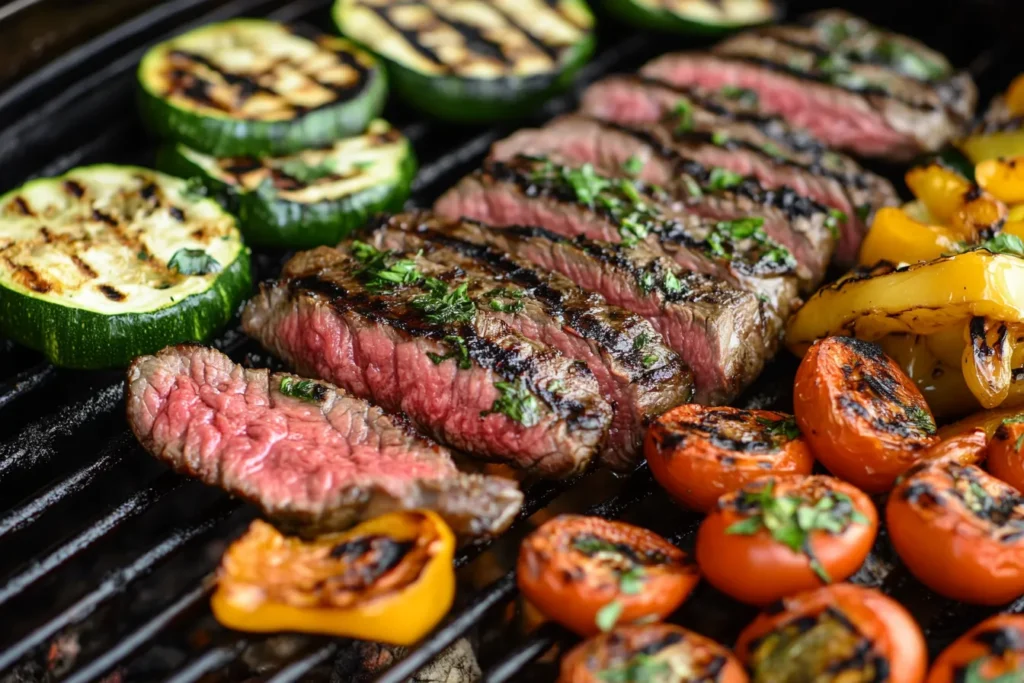
Appearance and Texture
Skirt steak is a long, flat cut of meat with visible muscle fibers running lengthwise. Its distinct appearance, with a coarse grain and uniform shape, makes it easy to identify. Unlike other steaks, it’s known for being relatively thin, which allows it to cook quickly. Check out more recipes here.
Fat Content and Marbling
While skirt steak has some marbling, it doesn’t compare to premium cuts like ribeye. Instead, the fat content in skirt steak serves to amplify its robust flavor rather than impart a buttery texture. This balance makes it perfect for grilling or pan-searing.
Flavor Profile
The standout feature of skirt steak is its deep, beefy flavor. When cooked correctly, it delivers a rich, juicy taste with a slightly chewy texture, making it a favorite for dishes like fajitas and Korean BBQ. Its flavor intensifies with marinades, further enhancing its reputation as a versatile choice.
Cuts Similar to Skirt Steak
Skirt steak is often compared to cuts like flank steak and hanger steak, but key differences set it apart:
- Flank Steak: Flank steak is leaner and slightly thicker but shares a similar long-grain structure. It’s also less forgiving if overcooked.
- Hanger Steak: Known as the “butcher’s steak,” hanger steak is more tender and flavorful but less common and pricier.
While all three cuts come from the lower regions of the cow, skirt steak stands out for its affordability and bold flavor. Check out more recipes here.
Types of Skirt Steak
Inside Skirt vs. Outside Skirt: Key Differences
- Inside Skirt: This is the more common of the two and is slightly thicker but narrower.
- Outside Skirt: Known for its superior tenderness and flavor, the outside skirt is less readily available and often preferred by chefs.
Despite these differences, both cuts are ideal for marination and high-heat cooking methods.
Availability and Popularity
Skirt steak has gained popularity due to its prominence in international cuisines. Although its availability may vary depending on your location, it remains a favorite for grilling enthusiasts and home cooks alike. Check out more recipes here.
Skirt Steak in Various Cuisines
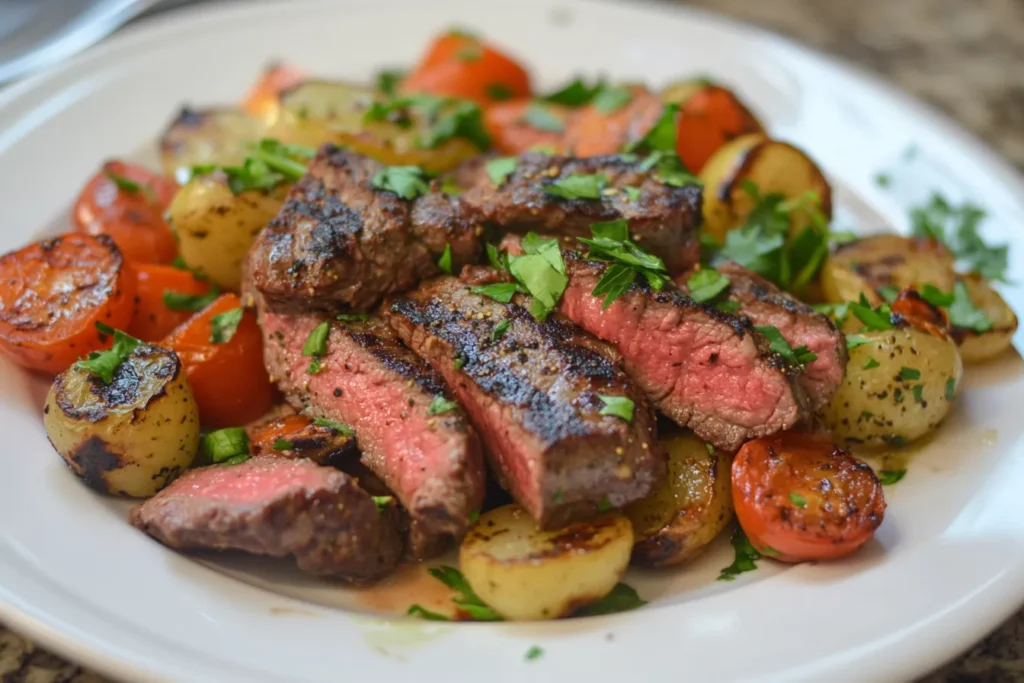
Skirt steak shines in a range of international dishes thanks to its robust flavor and adaptability:
- Mexican Cuisine: Skirt steak is the quintessential cut for fajitas and carne asada.
- Korean BBQ: Often marinated in soy, garlic, and sesame oil, it becomes a highlight in dishes like bulgogi.
- Argentine Cuisine: In Argentina, skirt steak is grilled and served as part of a traditional asado.
Its widespread use across cultures showcases its global appeal and culinary versatility. Check out more recipes here.
Is Skirt Steak Considered a Prime Cut?
Comparison to High-End Cuts
Skirt steak isn’t categorized as a prime cut like ribeye or tenderloin, but that doesn’t diminish its value. Unlike premium steaks known for their tenderness, skirt steak is celebrated for its flavor, making it a go-to for casual meals and barbecue feasts.
What Makes a Cut “Bad”?
A cut’s reputation hinges on factors such as texture, flavor, and price. While skirt steak’s texture may not suit everyone, its affordability and flavor ensure it holds a unique place among beef cuts.
The Cost of Skirt Stea
Skirt steak is generally more affordable than prime cuts, making it an attractive option for those seeking bold flavor without breaking the bank. However, rising demand in recent years has caused slight price increases, particularly for the coveted outside skirt.
Cooking Challenges with Skirt Steak
Skirt steak’s fibrous texture can be a challenge for some cooks. Overcooking leads to chewiness, while undercooking leaves it tough. To maximize tenderness, it’s essential to:
- Cook quickly over high heat.
- Slice against the grain.
Popular Misconceptions
There’s a misconception that skirt steak’s coarse texture makes it an inferior cut. In reality, proper preparation and cooking can transform it into a deliciously tender and flavorful dish.
Benefits of Skirt Steak
Intense Flavor Profile
One of the greatest advantages of skirt steak is its bold and beefy flavor. Unlike milder cuts like filet mignon, skirt steak has a rich taste that doesn’t require heavy seasoning or complex cooking techniques to stand out. This makes it perfect for marinades, which enhance its natural depth without overpowering the meat.
Whether used in Tex-Mex dishes like fajitas or international recipes such as bulgogi, the flavor is the primary reason many home cooks and chefs love this cut. Its ability to absorb marinades and spices quickly further elevates its versatility in the kitchen.
Versatility in Recipes
Skirt steak’s adaptability shines through in its wide range of uses. Here are just a few examples:
- Grilled for tacos or wraps.
- Stir-fried for Asian-inspired dishes.
- Thinly sliced for salads or sandwiches.
Its quick-cooking nature also means it’s ideal for weeknight meals where time is of the essence. A hot grill or cast-iron skillet can transform this cut into a mouthwatering dish in minutes.
Nutritional Value
Protein and Fat Content
Skirt steak is an excellent source of protein, providing around 23 grams per 4-ounce serving. While it contains more fat than leaner cuts like sirloin, this fat contributes to its unique flavor and succulence.
Vitamins and Minerals
In addition to protein, skirt steak offers important nutrients such as:
- Iron: Vital for energy production and preventing anemia.
- Zinc: Supports immune function and metabolism.
- Vitamin B12: Essential for nerve health and red blood cell production.
For those on a high-protein diet, skirt steak is a nutrient-rich choice that combines flavor with health benefits.
Skirt Steak as a Budget-Friendly Option
Skirt steak is often praised for its affordability compared to premium cuts like ribeye or New York strip. This makes it a popular choice for hosting large gatherings or family dinners without stretching the budget.
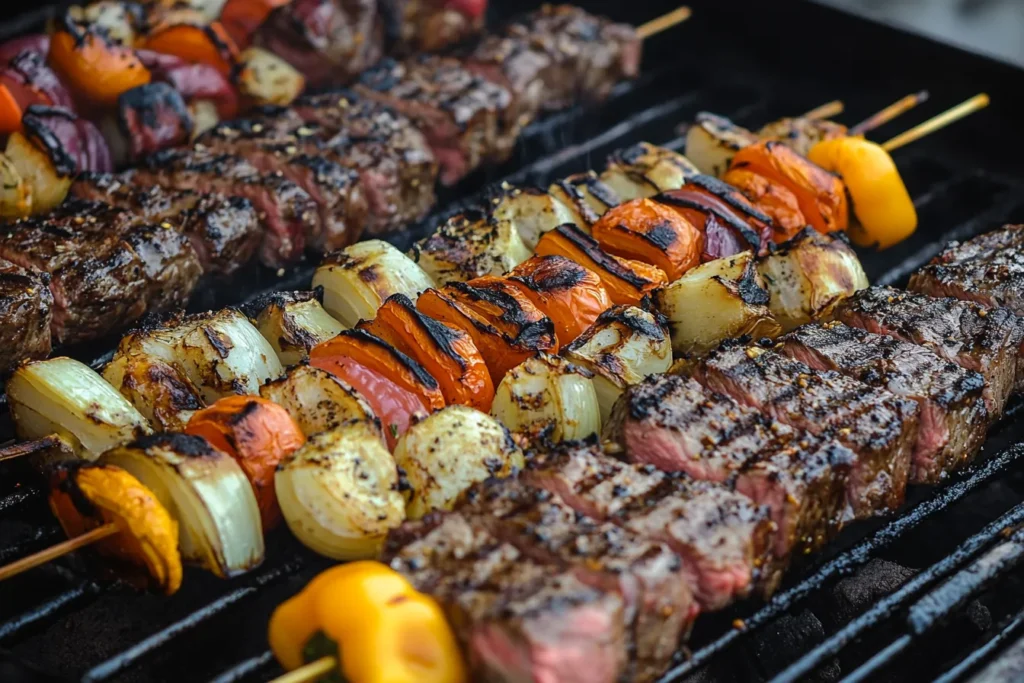
Economical Cuts for Large Gatherings
When cooking for a crowd, skirt steak is a practical option because:
- It cooks quickly, saving time.
- It pairs well with simple sides like grilled vegetables or tortillas.
- Its bold flavor satisfies without requiring complex sauces or garnishes.
Although prices have risen with demand, it remains a cost-effective way to enjoy quality beef.
Drawbacks of Skirt Steak
Toughness and Fibrous Texture
The most common criticism of skirt steak is its tough texture, especially if not prepared properly. Its muscle fibers are long and coarse, which can make it chewy when overcooked or improperly sliced.
To overcome this, cooks often:
- Use acidic marinades to break down muscle fibers.
- Cut the steak against the grain to achieve maximum tenderness.
Limited Uses in Fine Dining
While skirt steak excels in casual cooking, it’s rarely featured in fine dining establishments. Its rustic qualities make it less suitable for high-end presentations, where smoother textures and delicate flavors are often preferred.
Cooking Requirements
The Need for Marination
To enhance tenderness and flavor, marination is almost a necessity with skirt steak. Common marinades include:
- Citrus-based marinades: Lemon or lime juice works to tenderize the meat by breaking down tough fibers.
- Soy-based marinades: Popular in Asian dishes for a salty-sweet profile.
Skipping this step often results in a less enjoyable eating experience.
Proper Cooking Techniques
Skirt steak thrives when cooked over high heat for a short time. The aim is to create a perfectly charred exterior while maintaining a juicy interior. Popular methods include:
- Grilling.
- Broiling.
- Pan-searing.
Overcooking will render it tough, making it essential to keep a close eye on the timing.
Skirt Steak and Health Considerations
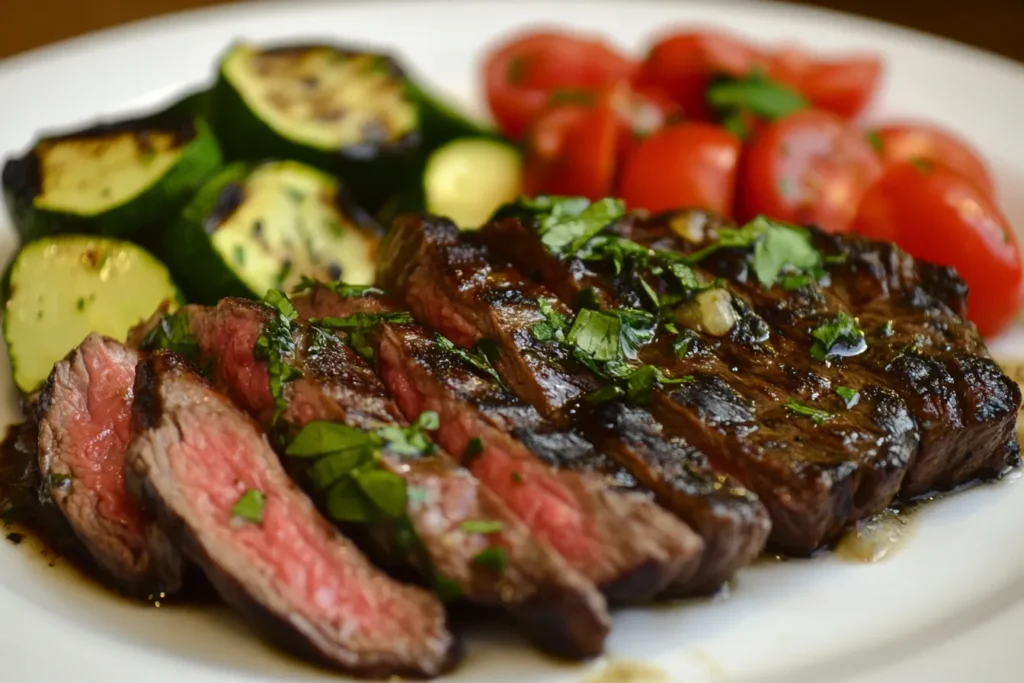
Fat Content
While skirt steak’s fat content contributes to its rich flavor, it may not align with all dietary goals. For those seeking leaner cuts, sirloin or eye of round may be better options. When enjoyed in moderation, skirt steak can be a healthy addition to a balanced diet.
Impact on Health-Conscious Diets
For health-conscious individuals, pairing skirt steak with nutrient-dense sides like steamed vegetables or quinoa can create a balanced, protein-packed meal. Its iron and zinc content make it particularly beneficial for those with high nutritional needs.
Skirt Steak vs. Other Affordable Cuts
Skirt steak isn’t the only economical option available. Here’s how it compares to other budget-friendly cuts:
- Chuck Roast: Better suited for slow cooking due to its high fat content and connective tissue.
- Brisket: Perfect for barbecuing, though it demands extended cooking times for optimal tenderness.
- Top Round: Leaner but less flavorful than skirt steak.
While each cut has its strengths, skirt steak’s quick cooking time and bold flavor often make it the preferred choice for busy cooks.
How Missteps Lead to Poor Results
Common Mistakes in Buying, Preparing, and Cooking
Even experienced cooks can make mistakes with skirt steak. Some common errors include:
- Overcooking: This turns the meat dry and chewy.
- Skipping the Marinade: Reduces both tenderness and flavor.
- Incorrect Slicing: Slicing with the grain instead of against it leads to tougher, chewier pieces.
Paying attention to these details can elevate the dish from ordinary to exceptional.
Consumer Preferences
Skirt steak divides opinion among consumers. Here’s why:
- Why Some Love It: Fans appreciate its intense flavor and versatility in recipes.
- Why Others Don’t: Some critics point to its chewiness or rustic texture as potential downsides.
Sustainability and Ethical Considerations
Skirt steak, derived from a less commonly used part of the cow, embodies sustainable eating practices. Opting for this cut helps minimize waste and encourages the efficient use of the entire animal.
Environmental Benefits
When compared to prime cuts, skirt steak has a smaller carbon footprint since it comes from a portion of the cow that would otherwise be less utilized.
Mastering Skirt Steak Cooking
Quick Cooking Tips for the Best Results
Cooking skirt steak may seem intimidating at first, but mastering a few key techniques ensures the perfect result every time. Due to its thinness and long muscle fibers, skirt steak benefits most from fast, high-heat cooking methods that bring out its bold flavor while minimizing toughness.
Here are essential tips for success:
- Ensure your grill or skillet is preheated to very high heat before you start cooking.
- Cook each side for no more than 2–3 minutes to maintain a medium-rare doneness.
- Always let the steak rest for 5–10 minutes before slicing to allow juices to redistribute.
These small steps transform skirt steak into a tender and flavorful masterpiece.
Preparing Skirt Steak
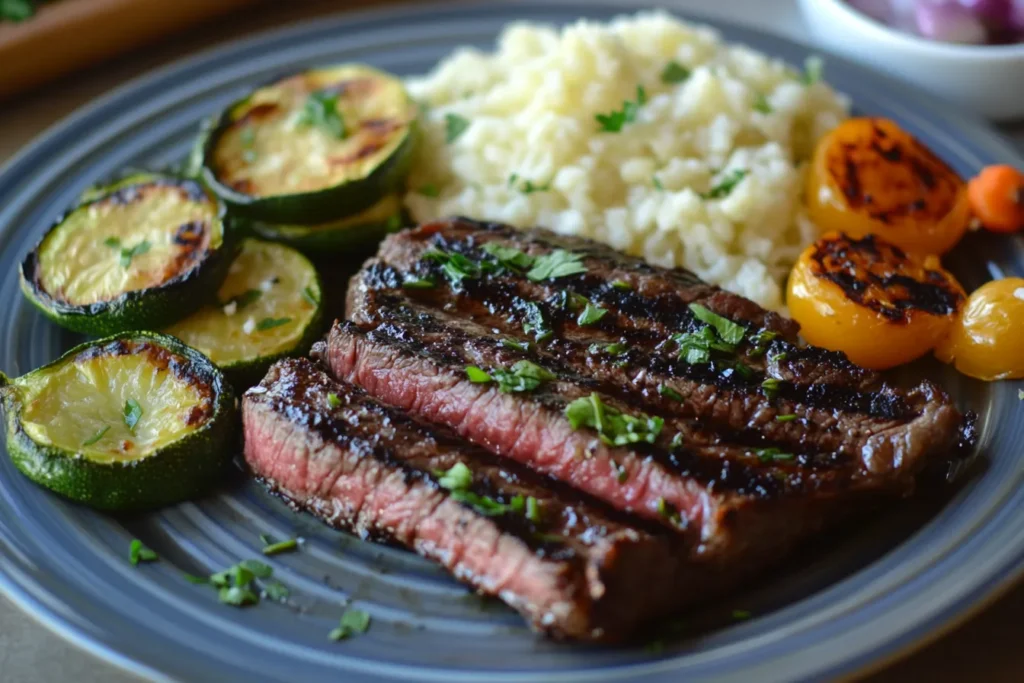
Trimming
Skirt steak often comes with a membrane or silver skin that must be removed for optimal cooking. Use a sharp knife to trim away excess fat or sinew, as this can affect both the texture and flavor.
Marinating
Marinating is a game-changer for skirt steak. The coarse grain allows it to soak up flavors quickly, making it ideal for acidic marinades with ingredients like:
- Lime juice
- Soy sauce
- Garlic
- Olive oil
Marinate the steak for a minimum of 30 minutes, or for optimal flavor, let it rest in the refrigerator for up to 8 hours.
Seasoning
For those short on time, a simple seasoning of salt, pepper, and garlic powder enhances the steak’s natural flavor without overpowering it.
Best Cooking Methods
Grilling
Grilling is the most popular method for skirt steak due to the intense heat and charred flavor it imparts. Place the steak on a hot grill and cook each side quickly. A medium-rare finish ensures the meat remains juicy.
Pan-Searing
A heavy cast-iron skillet is perfect for searing skirt steak. Heat the pan until it smokes slightly, then sear the steak for 2–3 minutes per side. Add butter or aromatics like garlic and rosemary for extra flavor.
Broiling
Broiling offers an excellent indoor alternative to grilling. Place the steak on a broiler pan close to the heat source, cooking each side for 2–3 minutes until the desired doneness is reached.
Skirt Steak in Tacos and Fajitas
Skirt steak is a quintessential ingredient in Tex-Mex cuisine, particularly in tacos and fajitas. Its bold flavor and tender slices pair beautifully with warm tortillas, fresh toppings, and zesty sauces.
Taco Pairings
- Top with chopped onions, cilantro, and a squeeze of lime for authentic street tacos.
- Add guacamole, salsa, or crema for a Tex-Mex twist.
Fajita Preparation
Cook the steak alongside bell peppers and onions, then serve sizzling on a skillet. This presentation is as visually appealing as it is delicious.
Pairing Skirt Steak with Sides
The right sides elevate a skirt steak meal, balancing its intense flavor with complementary textures and tastes. Popular accompaniments include:
- Grilled Vegetables: Asparagus, zucchini, and mushrooms add a smoky, earthy contrast.
- Starches: Rice pilaf, roasted potatoes, or corn tortillas make for a satisfying base.
- Salads: A light arugula salad with vinaigrette refreshes the palate.
For a complete meal, consider pairing skirt steak with bold sauces like chimichurri or garlic butter.
Skirt Steak Recipes Around the World
Skirt steak’s versatility is celebrated globally, with recipes that highlight its adaptability:
- Mexico: Marinated for carne asada and served with warm tortillas.
- Korea: Thinly sliced and marinated in soy, sesame, and garlic for bulgogi.
- Argentina: Grilled with simple seasonings and served with chimichurri as part of an asado.
These international preparations showcase how skirt steak seamlessly fits into diverse culinary traditions.
Achieving the Perfect Sear
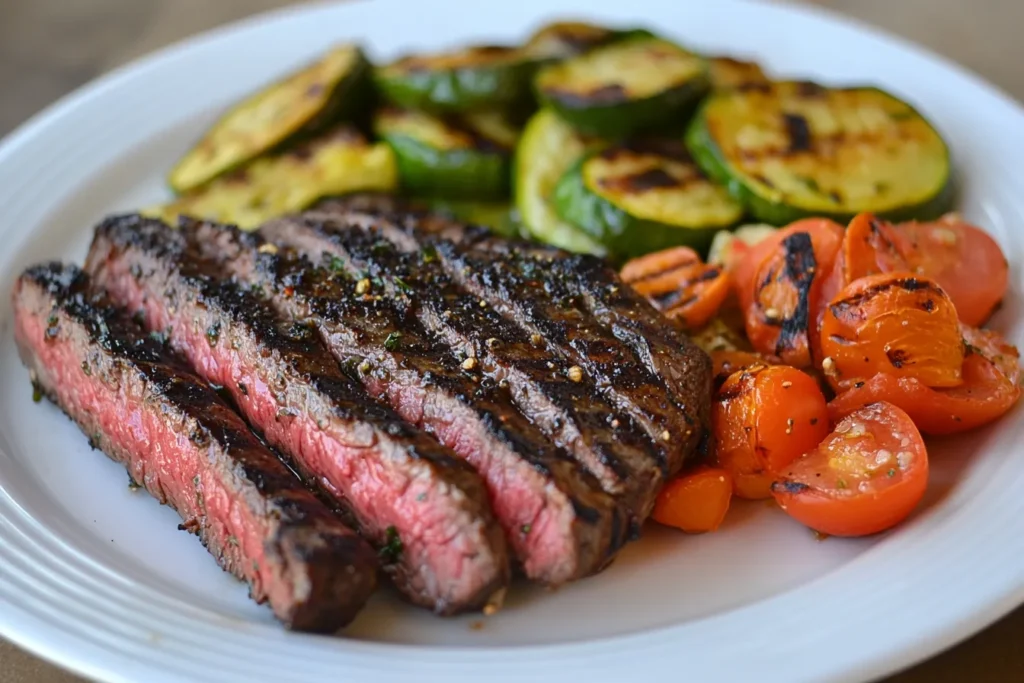
Tips for Locking in Flavor and Juiciness
A great sear is the hallmark of a well-cooked skirt steak. To achieve this:
- Pat the steak dry before cooking to promote even browning.
- Use a high-smoke-point oil like avocado or grapeseed.
- Avoid overcrowding the pan or grill, which can lower the temperature and result in steaming rather than searing.
A golden-brown crust not only enhances flavor but also adds a satisfying texture to each bite.
Resting and Slicing Skirt Steak
Importance of Resting After Cooking
- Locks in juices, preventing them from spilling out when sliced.
- Ensures an even distribution of flavor throughout the meat.
Cover the steak loosely with foil and rest it for at least 5 minutes before slicing.
Proper Slicing Against the Grain
Skirt steak’s long muscle fibers require special attention when slicing. Always slice against the grain into thin strips to minimize toughness and ensure tender bites.
Transforming Leftovers
Leftover skirt steak can be easily repurposed into new dishes, ensuring no part goes to waste. Creative ideas include:
- Sandwiches: Pile slices onto crusty bread with caramelized onions and melted cheese for a rich and satisfying steak sandwich.
- Salads: Toss into a Caesar salad or mixed greens for a protein boost.
- Stir-Fries: Combine with vegetables and soy sauce for a quick, flavorful stir-fry.
Enhancing Skirt Steak with Sauces and Marinades
The right sauce or marinade can transform skirt steak into a gourmet experience. Popular options include:
- Chimichurri: A traditional Argentine sauce crafted from parsley, garlic, olive oil, and a touch of vinegar.
- Teriyaki Glaze: Adds a sweet and savory twist, perfect for Asian-inspired dishes.
- Garlic Butter: Simple yet luxurious, it amplifies the steak’s natural flavors.
Experimenting with different sauces allows for endless customization.
FAQs
1. What part of the cow does skirt steak come from?
Skirt steak is cut from the diaphragm muscle of the cow, located near the plate or belly area. This location gives it its signature coarse texture and bold flavor.
2. What’s the difference between inside skirt and outside skirt steak?
- Inside Skirt: Thicker and less tender, but more widely available.
- Outside Skirt: Thinner, more flavorful, and tender but harder to find and often more expensive.
3. How long should I marinate skirt steak?
Marinate skirt steak for at least 30 minutes to allow the flavors to penetrate. For best results, aim for 4–8 hours in the refrigerator.
4. Why is it important to slice skirt steak against the grain?
Cutting against the grain shortens the long muscle fibers, making the steak easier to chew and more tender.
5. Can I freeze skirt steak?
Yes, skirt steak freezes well. Wrap it tightly in plastic wrap or freezer paper and store it in an airtight container for up to 3 months.
6. What’s the best cooking method for skirt steak?
Grilling is the most popular method, but pan-searing and broiling also work well. The key is high heat and a short cooking time to preserve tenderness.
7. Is skirt steak healthy?
Skirt steak is a good source of protein, iron, and zinc, but it’s higher in fat compared to leaner cuts. It can fit into a balanced diet when paired with healthy sides.
8. What’s the difference between skirt steak and flank steak?
- Skirt Steak: Thinner, more flavorful, and coarser in texture.
- Flank Steak: Thicker, leaner, and slightly less flavorful but easier to tenderize.
9. Can I use skirt steak for stews or slow cooking?
While skirt steak is best for quick cooking, it can be used in stews if sliced thinly and added toward the end of the cooking process to avoid overcooking.
10. How do I avoid overcooking skirt steak?
To prevent overcooking:
- Use a meat thermometer to check for a medium-rare temperature of 130–135°F (54–57°C).
- Cook quickly over high heat, no more than 2–3 minutes per side.
